D Link DI624MA1 802.11g WLAN Mini-PCI Module User Manual 1
D Link Corporation 802.11g WLAN Mini-PCI Module 1
D Link >
Contents
- 1. User Manual 1 of 2 for Access Poiint
- 2. User Manual 2 of 2 for Access Poiint
User Manual 2 of 2 for Access Poiint
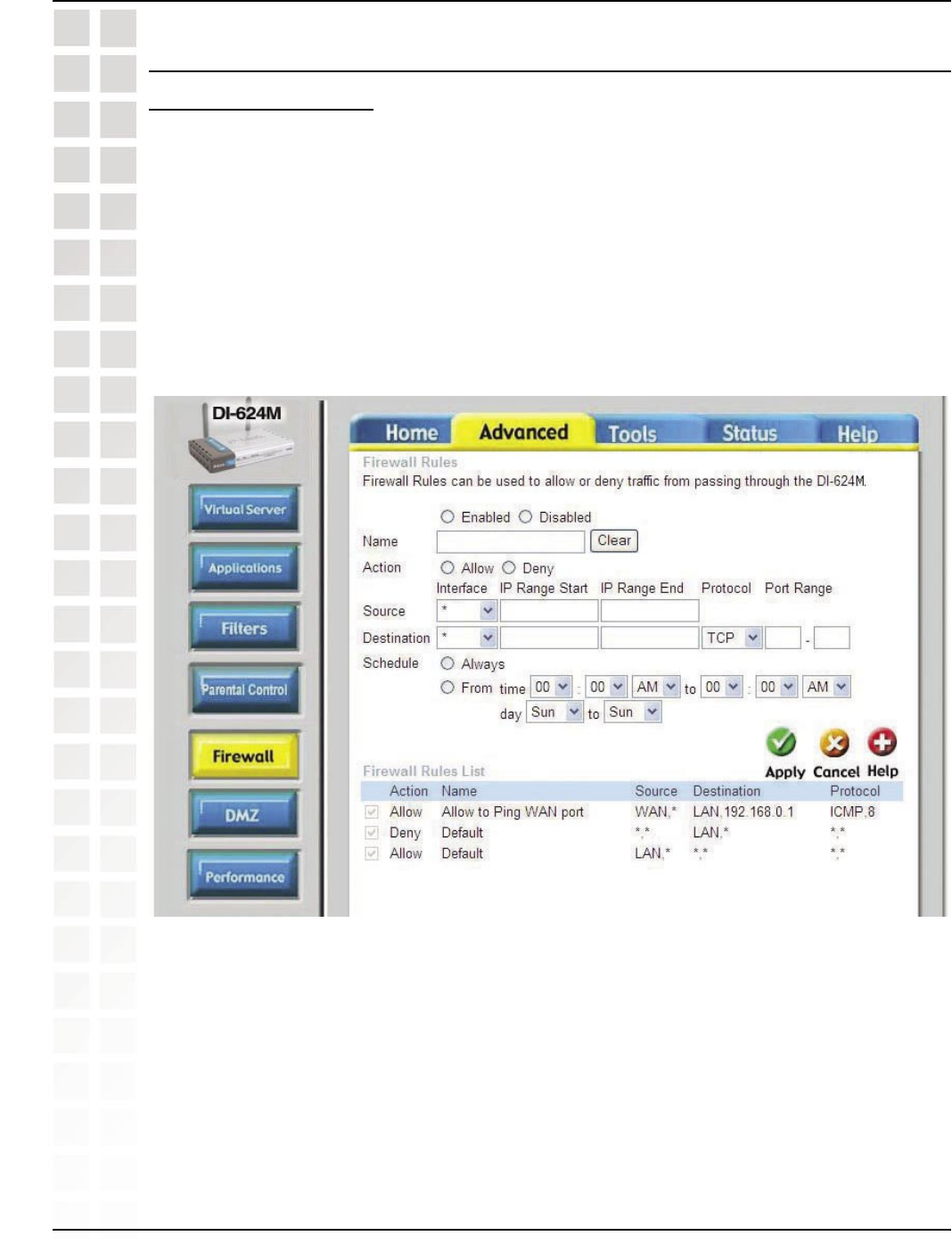
91
DI-624M User’s Manual
D-Link Systems, Inc.
Frequently Asked Questions
8 How do I open a range of ports on my DI-624M using
Firewall rules?
Step 1: Access the router’s Web configuration by entering the router’s IP Address in
your Web browser. The default IP Address is 192.168.0.1. Login using your password.
The default username is “admin” and the password is blank.
If you are having difficulty accessing Web management, please see the first question
in this section.
Step 2: From the Web management Home page, click the Advanced tab then click
the Firewall button.
Step 3: Click on Enabled and type in a name for the new rule.
Step 4: Choose WAN as the Source and enter a range of IP Addresses out on the
internet that you would like this rule applied to. If you would like this rule to allow all
internet users to be able to access these ports, then put an Asterisk in the first box
and leave the second box empty.
Step 5: Select LAN as the Destination and enter the IP Address of the computer on
your local network that you want to allow the incoming service to. This will not work
with a range of IP Addresses.
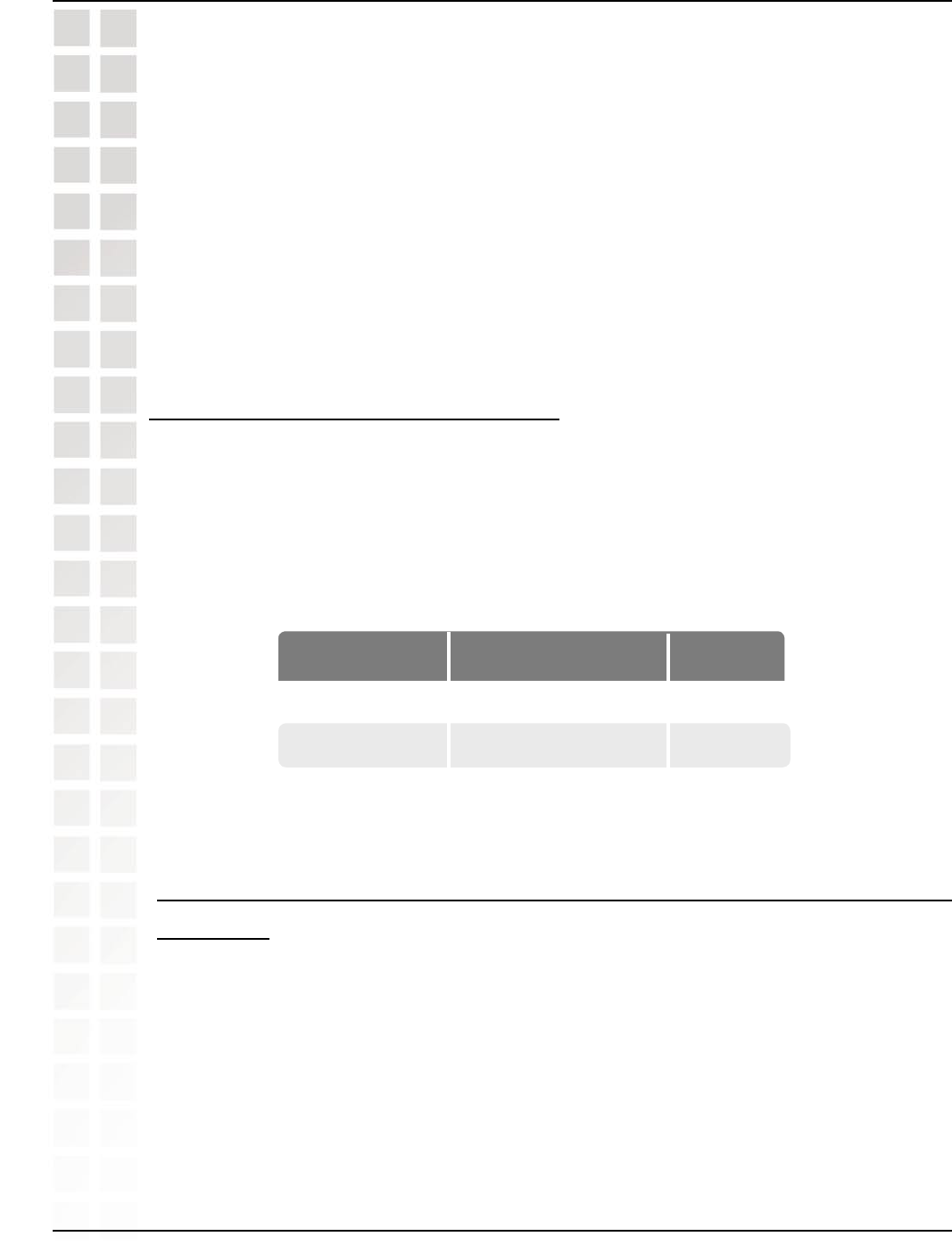
92
DI-624M User’s Manual
D-Link Systems, Inc.
Frequently Asked Questions
Step 6: Enter the port or range of ports that are required to be open for the incoming
service.
Step 7: Click Apply and then click Continue.
Note: Make sure DMZ host is disabled.
Because our routers use NAT (Network Address Translation), you can only open a
specific port to one computer at a time. For example: If you have 2 web servers on
your network, you cannot open port 80 to both computers. You will need to configure 1
of the web servers to use port 81. Now you can open port 80 to the first computer and
then open port 81 to the other computer.
9 What are virtual servers?
A Virtual Server is defined as a service port, and all requests to this port will be redirected
to the computer specified by the server IP. For example, if you have an FTP Server
(port 21) at 192.168.0.5, a Web server (port 80) at 192.168.0.6, and a VPN server at
192.168.0.7, then you need to specify the following virtual server mapping table:
10 How do I use PC Anywhere with my DI-624M
router?
You will need to open 3 ports in the Virtual Server section of your D-Link router.
Step 1: Open your web browser and enter the IP Address of the router
(192.168.0.1).
Server Port Server IP Enable
21 192.168.0.5 X
80 192.168.0.6 X
1723 192.168.0.7 X
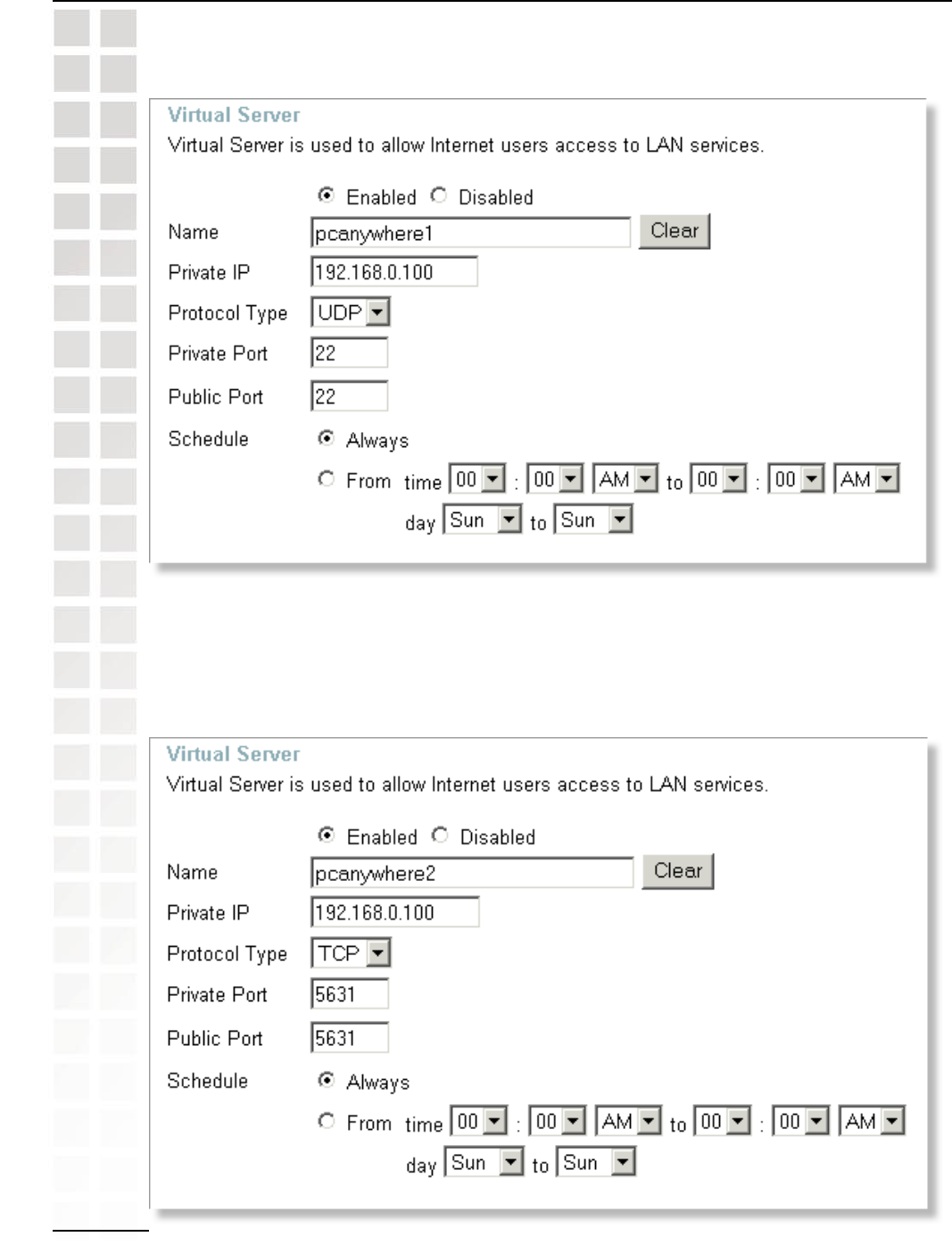
93
DI-624M User’s Manual
D-Link Systems, Inc.
Frequently Asked Questions
Step 3: Enter the information as seen below. The Private IP is the IP Address of the
computer on your local network that you want to connect to.
Step 4: The first entry will read as shown above.
Step 5: Click Apply and then click Continue.
Step 6: Create a second entry as shown below:
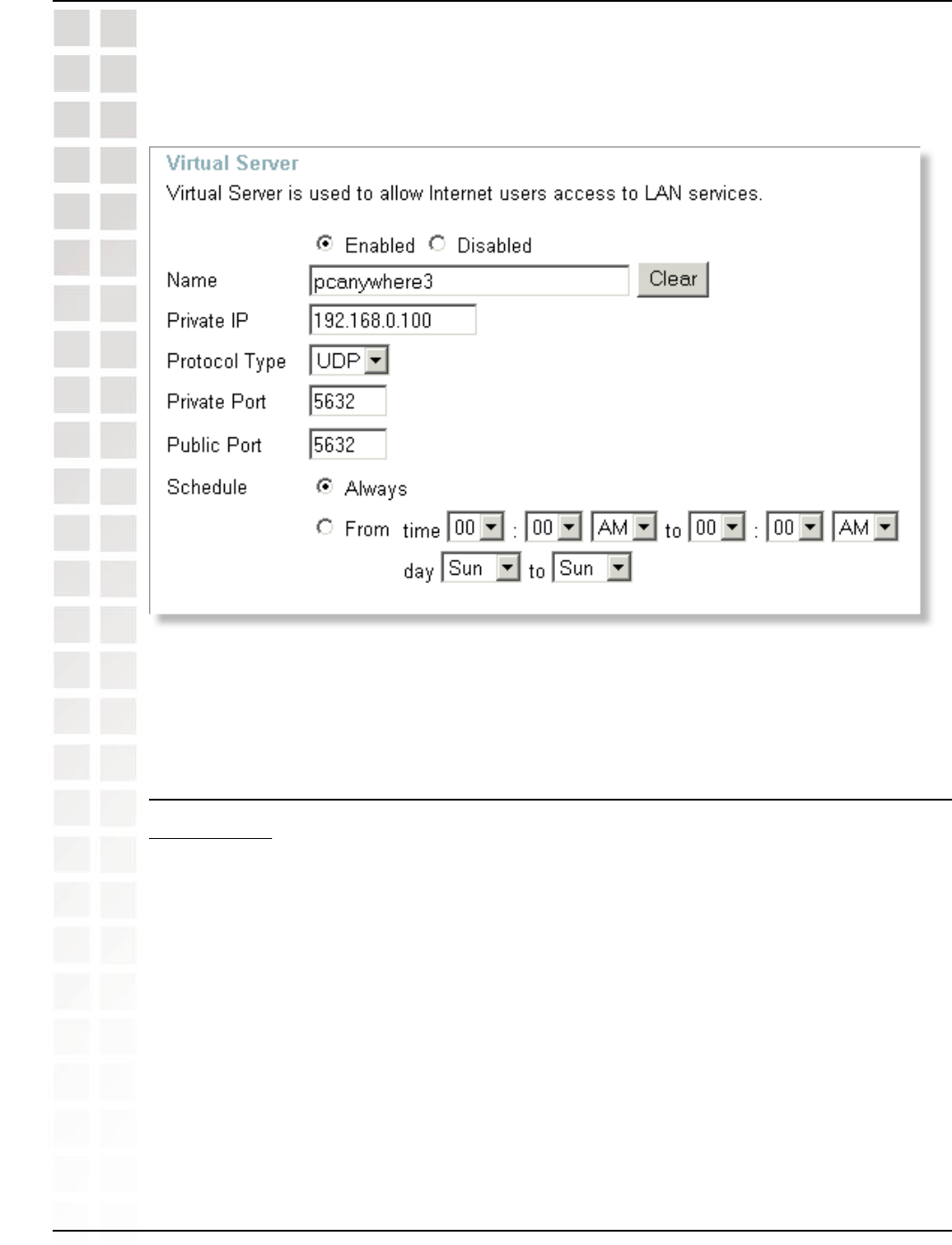
94
DI-624M User’s Manual
D-Link Systems, Inc.
Frequently Asked Questions
Step 7: Click Apply and then click Continue.
Step 8: Create a third and final entry as shown below:
Step 9: Click Apply and then click Continue.
Step 10: Run PCAnywhere from the remote site and use the WAN IP Address of the
router, not your computer´s IP Address.
11 How can I use eDonkey behind my D-Link
Router?
You must open ports on your router to allow incoming traffic while using eDonkey.
eDonkey uses three ports (4 if using CLI):
4661 (TCP) To connect with a server
4662 (TCP) To connect with other clients
4665 (UDP) To communicate with servers other than the one you are connected to.
4663 (TCP) *Used with the command line (CLI) client when it is configured to allow
remote connections. This is the case when using a Graphical Interface (such as the
Java Interface) with the client.
Step 1: Open your web browser and enter the IP Address of your router (192.168.0.1).
Enter username (admin) and your password (leave blank).
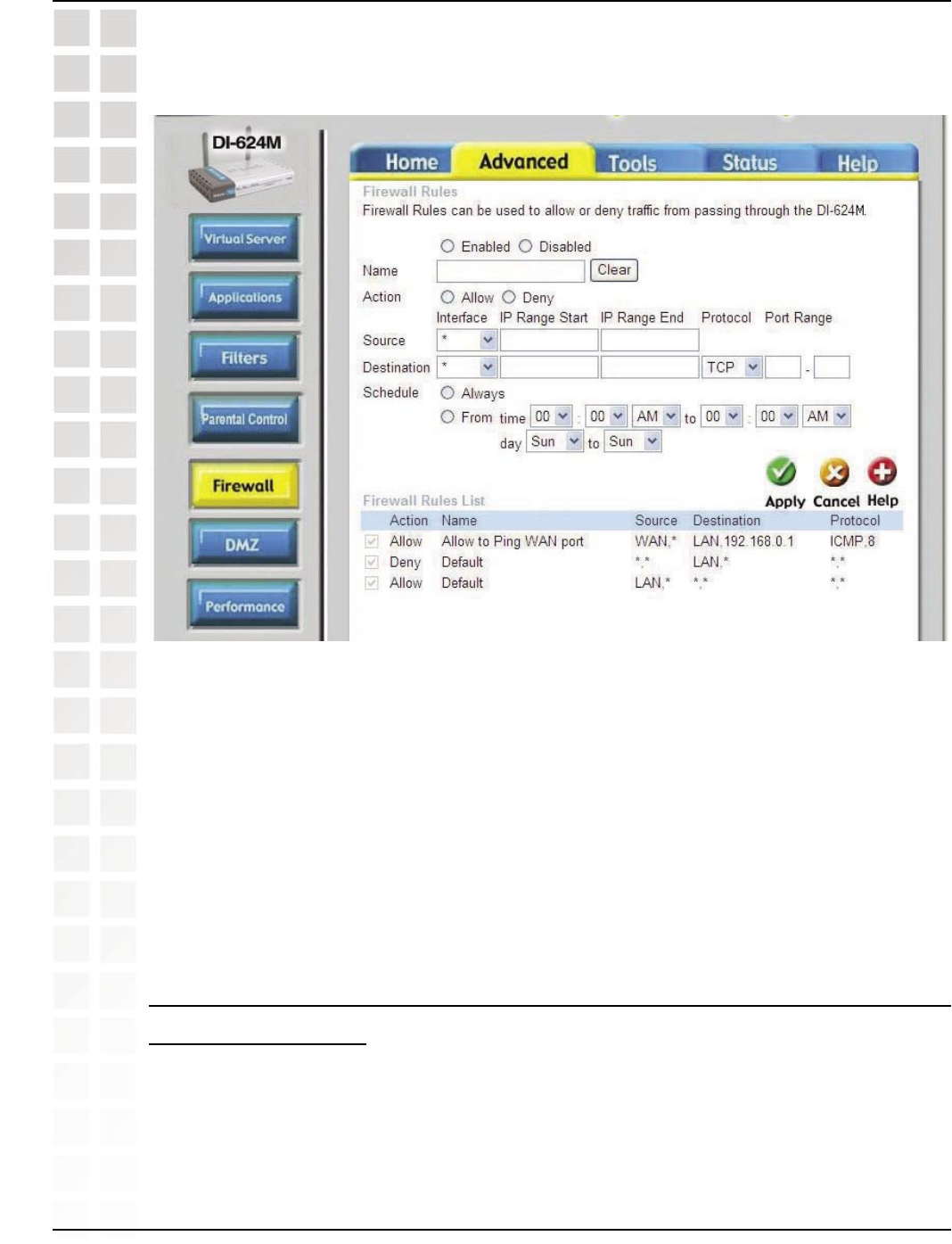
95
DI-624M User’s Manual
D-Link Systems, Inc.
Frequently Asked Questions
Step 2: Click on Advanced and then click Firewall.
Step 3: Create a new firewall rule:
Click Enabled. Enter a name (edonkey). Click Allow. Next to Source, select WAN
under interface. In the first box, enter an *. Leave the second box empty. Next to
Destination, select LAN under interface. Enter the IP Address of the computer you are
running eDonkey from. Leave the second box empty. Under Protocol, select *. In the
port range boxes, enter 4661 in the first box and then 4665 in the second box. Click
Always or set a schedule.
Step 4: Click Apply and then Continue.
12 How do I set up my router for SOCOM on my
Playstation 2?
To allow you to play SOCOM and hear audio, you must download the latest firmware
for the router (if needed), enable Game Mode, and open port 6869 to the IP Address
of your Playstation.
Step 1: Upgrade firmware (follow link above).

96
DI-624M User’s Manual
D-Link Systems, Inc.
Frequently Asked Questions
Step 2: Open your web browser and enter the IP Address of the router (192.168.0.1).
Enter username (admin) and your password (blank by default).
Step 3: Click on the Advanced tab and then click on Virtual Server on the left side.
Step 4: You will now create a new Virtual Server entry. Click Enabled and enter a name
(socom). Enter the IP Address of your Playstation for Private IP.
Step 5: For Protocol Type select Both. Enter 6869 for both the Private Port and Public
Port. Click Always. Click Apply to save changes and then Continue.
Step 6: Click on the Tools tab and then Misc on the left side.
Step 7: Make sure Gaming Mode is Enabled. If not, click Enabled. Click Apply and
then Continue.
13 How can I use Gamespy behind my D-Link
router?
Step 1: Open your web browser and enter the IP Address of the router (192.168.0.1).
Enter admin for the username and your password (blank by default).
socom
192.168.0.100
Both
6869
6869
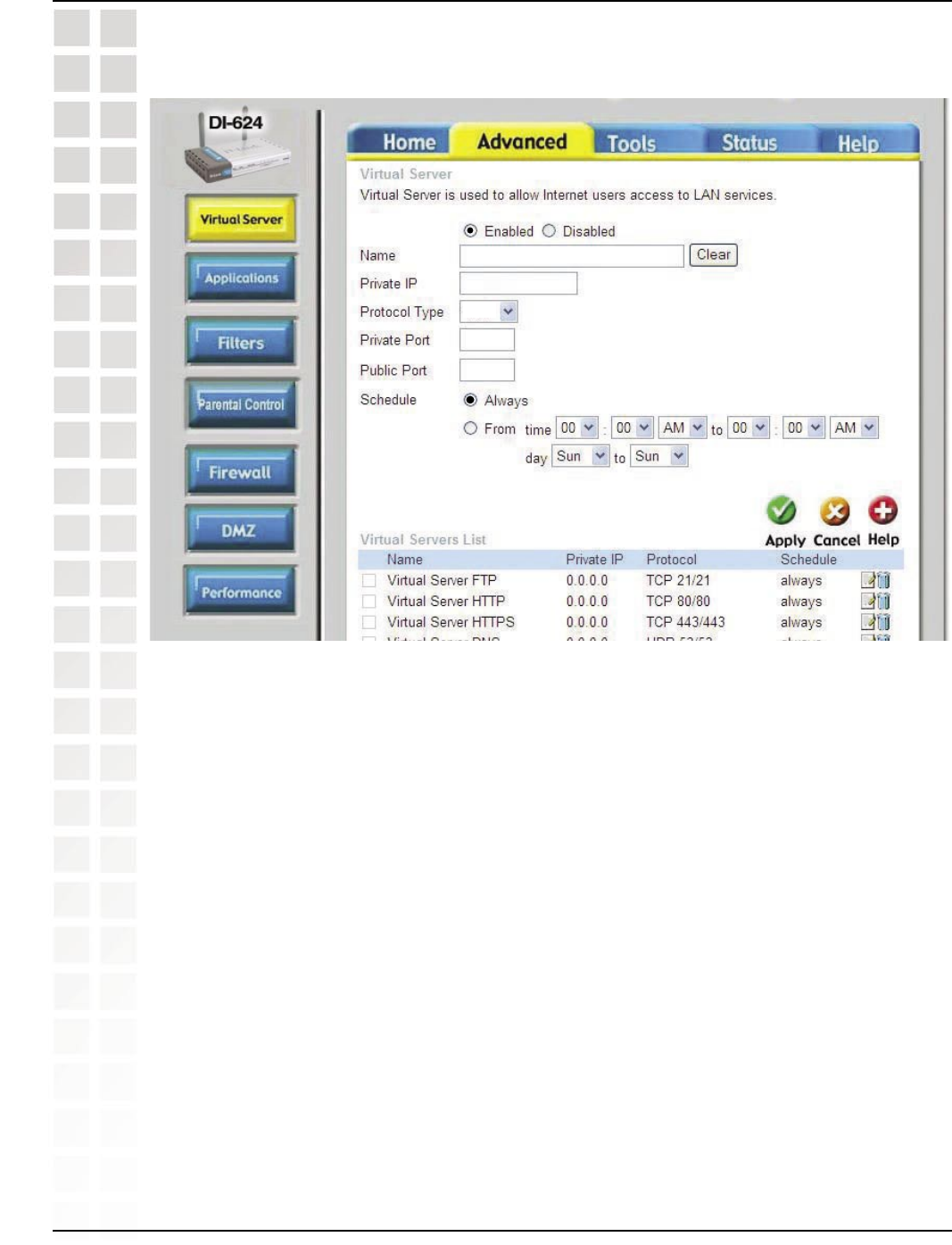
97
DI-624M User’s Manual
D-Link Systems, Inc.
Frequently Asked Questions
Step 3: You will create 2 entries.
Step 4: Click Enabled and enter Settings:
NAME - Gamespy1
PRIVATE IP - The IP Address of your computer that you are running Gamespy from.
PROTOCOL TYPE - Both
PRIVATE PORT - 3783
PUBLIC PORT - 3783
SCHEDULE - Always.
Click Apply and then continue..
Both
192.168.0.100
gamespy1
3783
3783
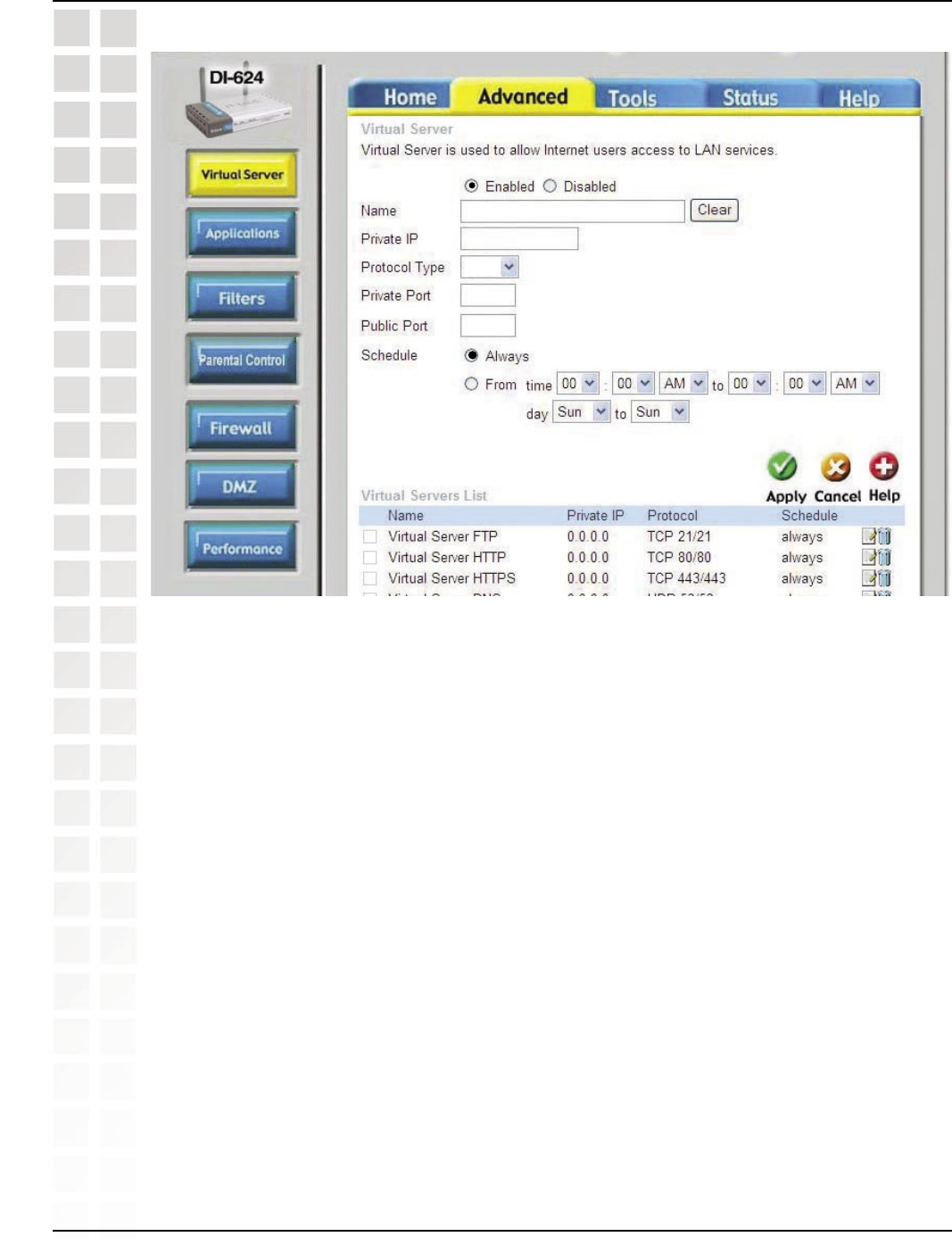
98
DI-624M User’s Manual
D-Link Systems, Inc.
Frequently Asked Questions
Step 5: Enter 2nd entry:
Click Enabled.
Enter the following information:
NAME - Gamespy2
PRIVATE IP - The IP Address of your computer that you are running Gamespy from.
PROTOCOL TYPE - Both
PRIVATE PORT - 6500
PUBLIC PORT - 6500
SCHEDULE - Always.
Click Apply and then continue.
192.168.0.100
gamespy2
6500
6500
Both

99
DI-624M User’s Manual
D-Link Systems, Inc.
Frequently Asked Questions
14 How do I configure my router for KaZaA and
Grokster?
The following is for KaZaA, Grokster, and others using the FastTrack P2P file sharing
system.
In most cases, you do not have to configure anything on the router or on the Kazaa
software. If you are having problems, please follow steps below:
Step 1: Enter the IP Address of your router in a web browser (192.168.0.1).
Step 2: Enter your username (admin) and your password (blank by default).
Step 3: Click on Advanced and then click Virtual Server.
Step 4: Click Enabled and then enter a Name (kazaa for example).
Step 5: Enter the IP Address of the computer you are running KaZaA from in the Private
IP box. Select TCP for the Protocol Type.
Step 6: Enter 1214 in the Private and Public Port boxes. Click Always under schedule
or set a time range. Click Apply.
Make sure that you did not enable proxy/firewall in the KaZaA software.

100
DI-624M User’s Manual
D-Link Systems, Inc.
Frequently Asked Questions
15 How do I configure my router to play Warcraft 3?
You must open ports on your router to allow incoming traffic while hosting a game in
Warcraft 3. To play a game, you do not have to configure your router.
Warcraft 3 (Battlenet) uses port 6112.
Step 1: Open your web browser and enter the IP Address of your router (192.168.0.1).
Enter username (admin) and your password (leave blank).
Step 2: Click on Advanced and then click Virtual Server.
Step 3: Create a new entry: Click Enabled. Enter a name (warcraft3). Private IP - Enter
the IP Address of the computer you want to host the game. Select Both for Protocol
Type Enter 6112 for both Private Port and Public Port Click Always or set a schedule.
Step 4 Click Apply and then Continue.
Note: If you want multiple computers from you LAN to play in the same game that
you are hosting, then repeat the steps above and enter the IP Addresses of the other
computers. You will need to change ports. Computer #2 can use port 6113, computer
#3 can use 6114, and so on.
192.168.0.100
warcraft3
6112
6112
Both
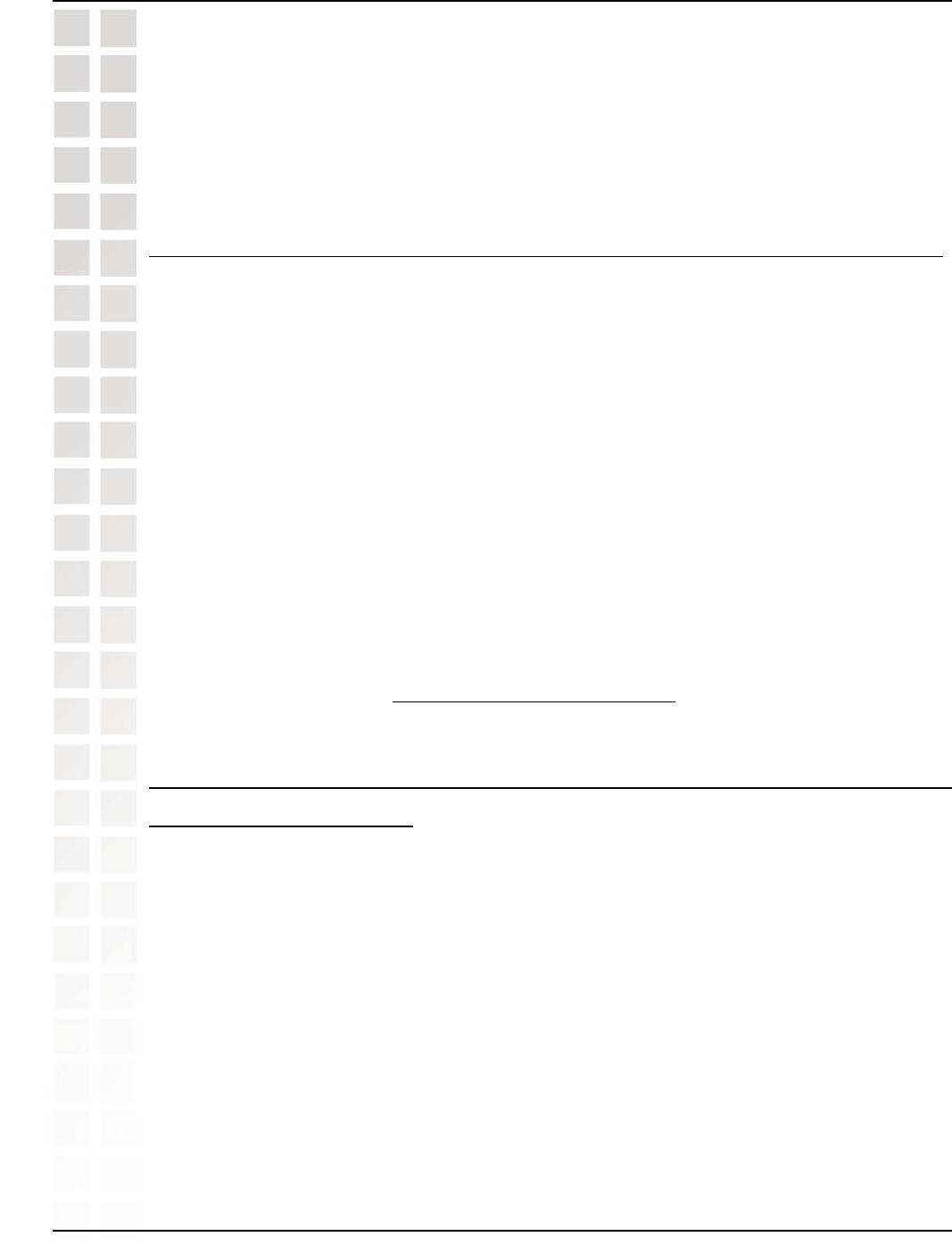
101
DI-624M User’s Manual
D-Link Systems, Inc.
Frequently Asked Questions
You will need to change the port information within the Warcraft 3 software for computers
#2 and up.
Configure the Game Port information on each computer:
Start Warcraft 3 on each computer, click Options > Gameplay. Scroll down and you
should see Game Port. Enter the port number as you entered in the above steps.
16 How do I use NetMeeting with my D-Link Router?
Unlike most TCP/IP applications, NetMeeting uses DYNAMIC PORTS instead of STATIC
PORTS. That means that each NetMeeting connection is somewhat different than the
last. For instance, the HTTP web site application uses port 80. NetMeeting can use
any of over 60,000 different ports.
All broadband routers using (only) standard NAT and all internet sharing programs like
Microsoft ICS that use (only) standard NAT will NOT work with NetMeeting or other
h.323 software packages.
The solution is to put the router in DMZ.
Note: A few hardware manufacturers have taken it on themselves to actually provide
H.323 compatibility. This is not an easy task since the router must search each incoming
packet for signs that it might be a netmeeting packet. This is a whole lot more work
than a router normally does and may actually be a weak point in the firewall. D-Link
is not one of the manufacturers.
To read more on this visit http://www.HomenetHelp.com.
17 How do I set up my router to use iChat? -for
Macintosh users-
You must open ports on your router to allow incoming traffic while using iChat.
iChat uses the following ports: 5060 (UDP) 5190 (TCP) File Sharing 16384-16403
(UDP) To video conference with other clients.
Step 1: Open your web browser and enter the IP Address of your router (192.168.0.1).
Enter username (admin) and your password (leave blank).
Step 2: Click on Advanced and then click Firewall.
Step 3: Create a new firewall rule:
Click Enabled.
Enter a name (ichat1).
Click Allow.
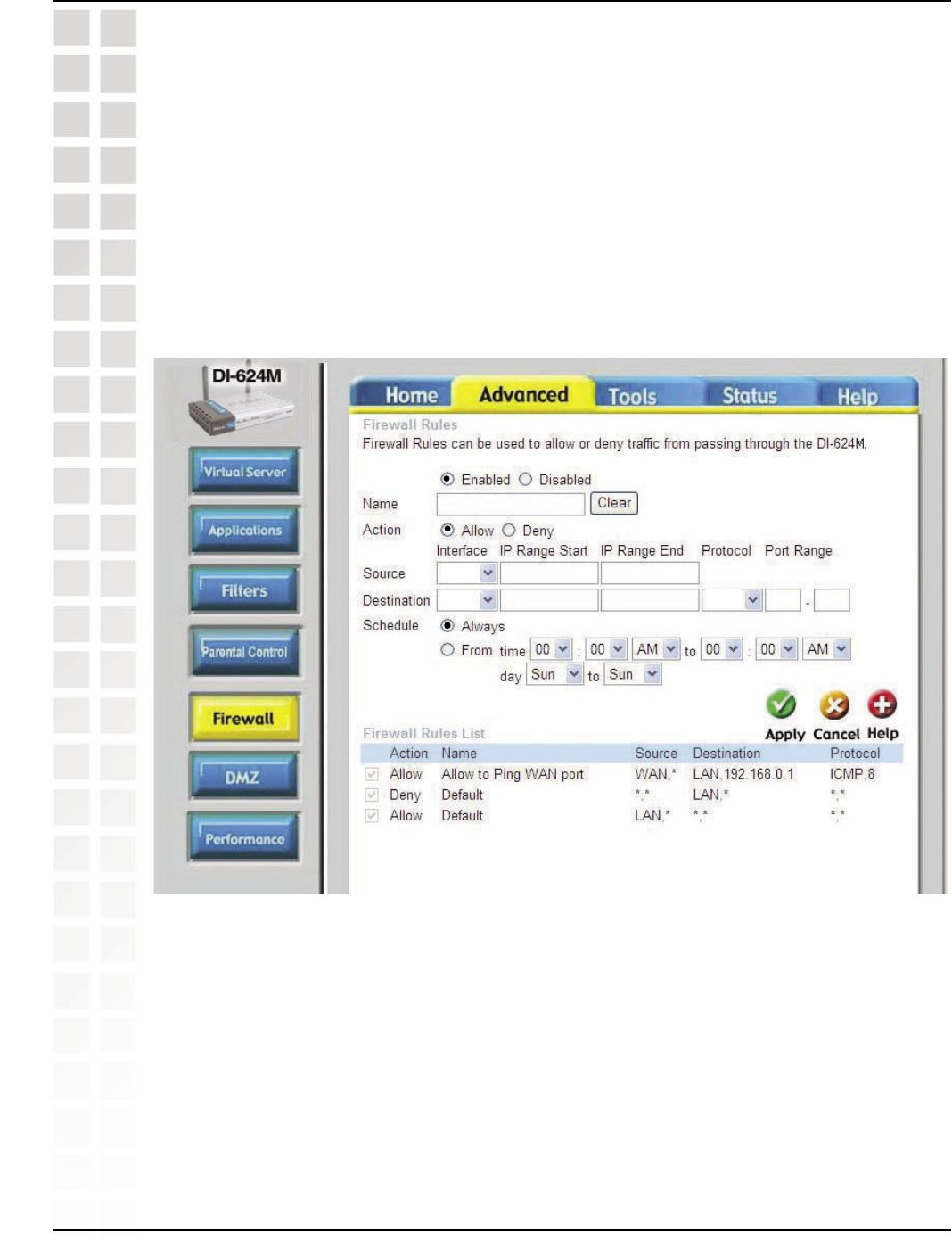
102
DI-624M User’s Manual
D-Link Systems, Inc.
Frequently Asked Questions
Next to Source, select WAN under interface.
In the first box, enter an *.
Leave the second box empty.
Next to Destination, select LAN under interface.
Enter the IP Address of the computer you are running iChat from.
Leave the second box empty. Under Protocol, select UDP. In the port range boxes,
enter 5060 in the first box and leave the second box empty.
Click Always or set a schedule.
192.168.0.100
ichat1
*
5060
UDP
WAN
LAN
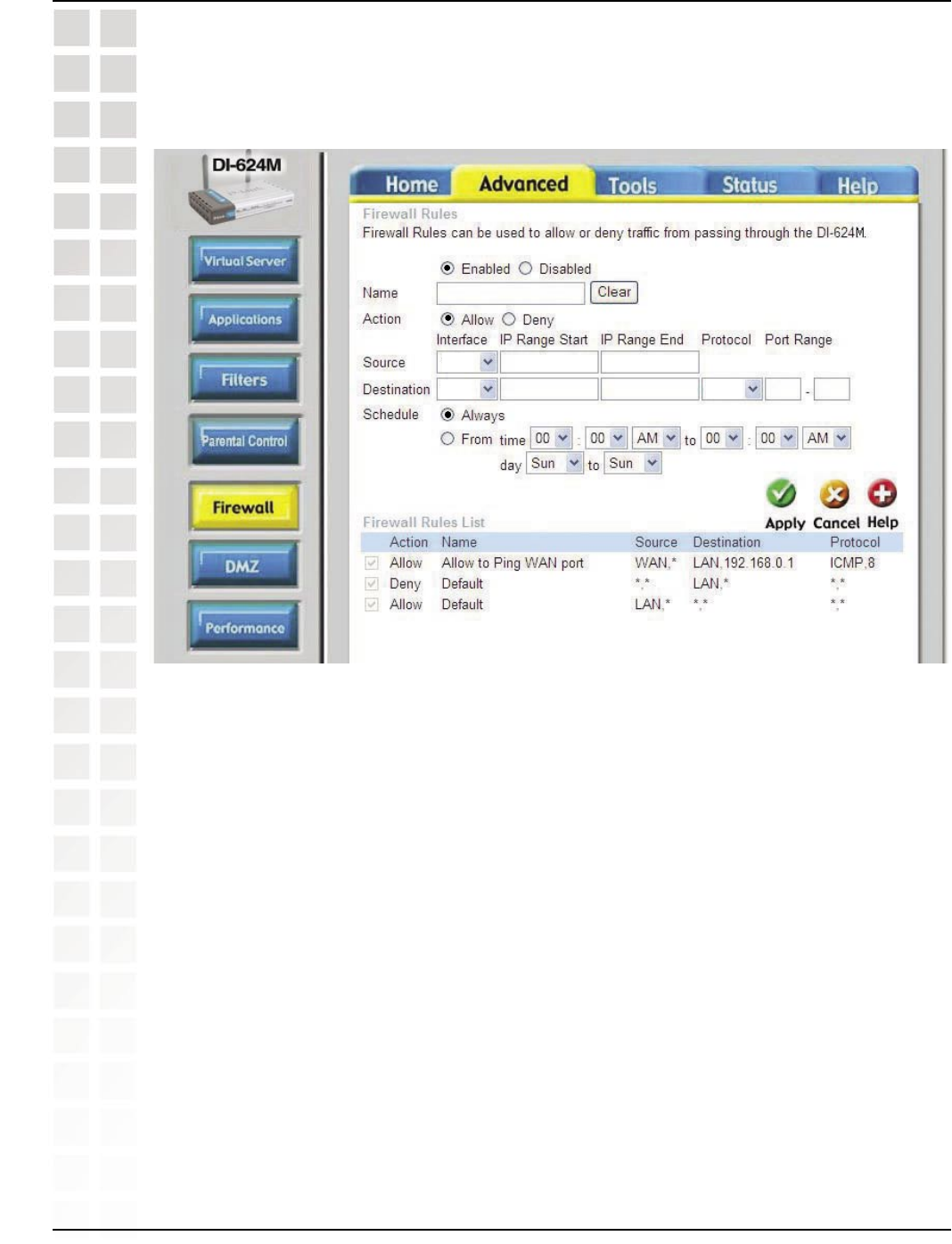
103
DI-624M User’s Manual
D-Link Systems, Inc.
Frequently Asked Questions
Step 4: Click Apply and then Continue.
Step 5: Repeat steps 3 and 4 enter ichat2 and open ports 16384-16403 (UDP).
For File Sharing:
Step 1: Click on Advanced and then Virtual Server.
Step 2: Check Enabled to activate entry.
Step 3: Enter a name for your virtual server entry (ichat3).
Step 4: Next to Private IP, enter the IP Address of the computer on your local network
that you want to allow the incoming service to.
Step 5: Select TCP for Protocol Type.
Step 6: Enter 5190 next to Private Port and Public Port.
Step 7: Click Always or configure a schedule.
Step 8: Click Apply and then Continue.
192.168.0.100
ichat2
*
16384
UDP
WAN
LAN 16403
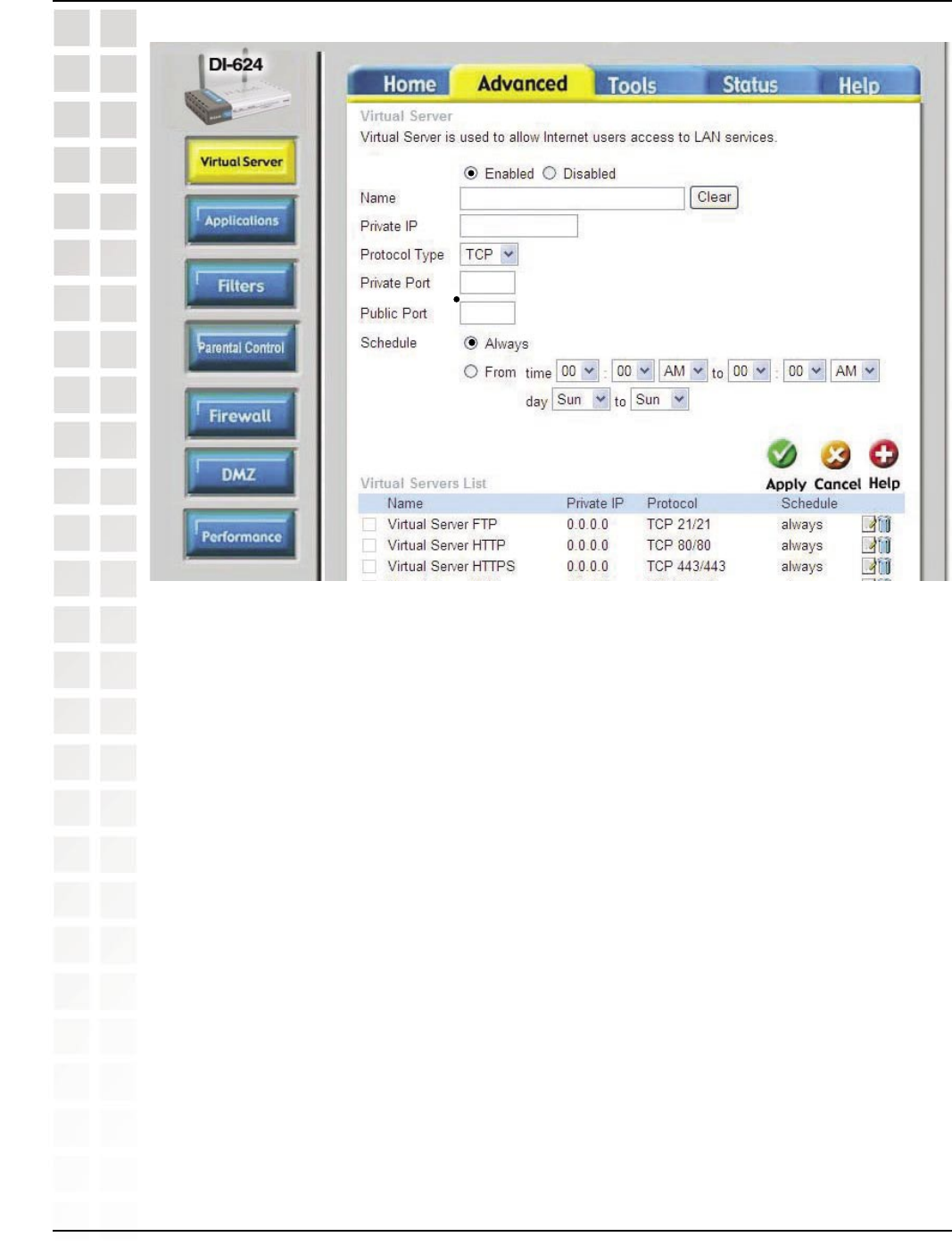
104
DI-624M User’s Manual
D-Link Systems, Inc.
Frequently Asked Questions
If using Mac OS X Firewall, you may need to temporarily turn off the firewall in the
Sharing preference pane on both computers.
To use the Mac OS X Firewall, you must open the same ports as in the router:
Step 1: Choose Apple menu > System Preferences.
Step 2: Choose View > Sharing.
Step 3: Click the Firewall tab.
Step 4: Click New.
Step 5: Choose Other from the Port Name pop-up menu.
Step 6: In the Port Number, Range or Series field, type in: 5060, 16384-16403.
Step 7: In the Description field type in: iChat AV
Step 8: Click OK.
192.168.0.100
ichat3
*
5190
5190
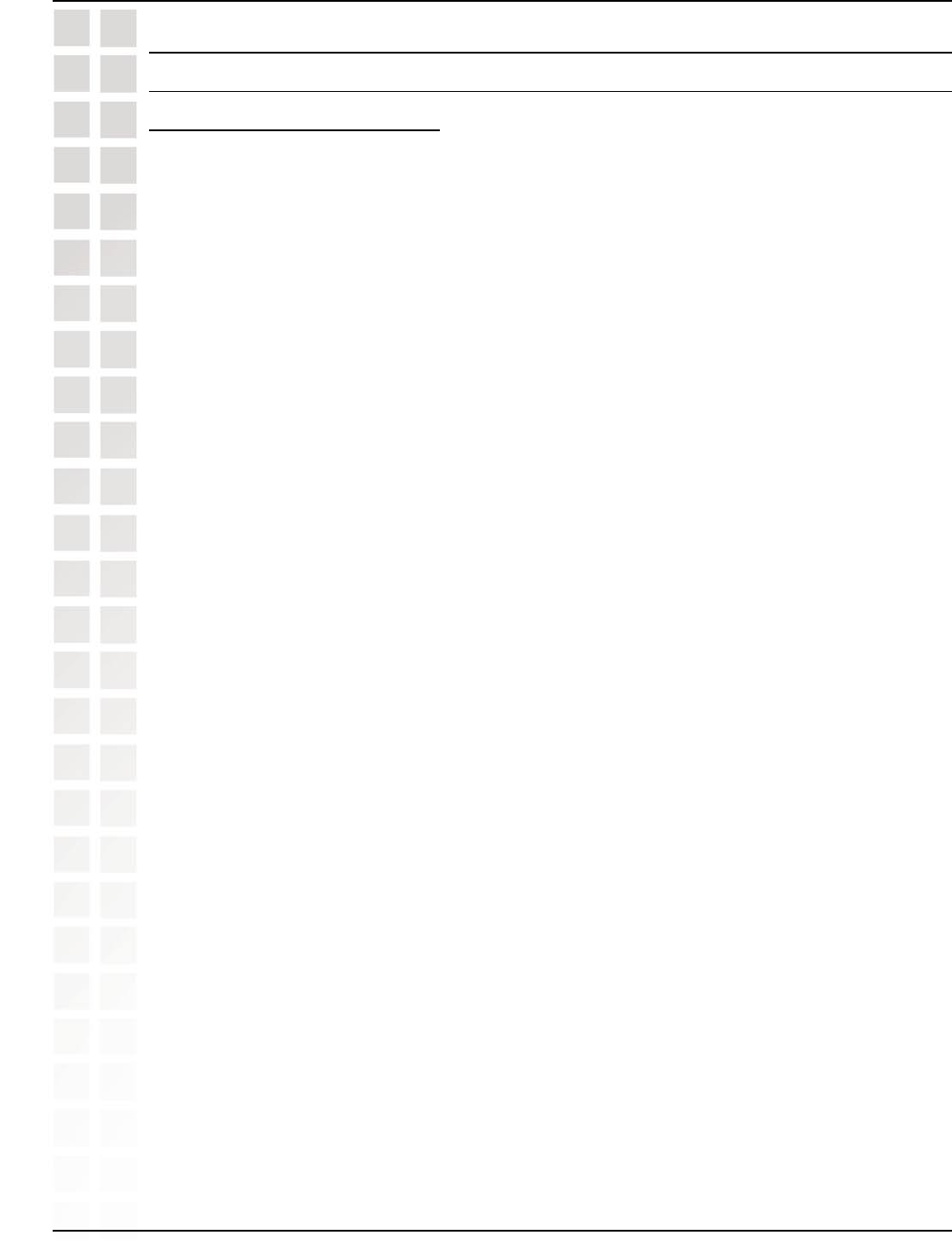
105
DI-624M User’s Manual
D-Link Systems, Inc.
Frequently Asked Questions
17 How do I send or receive a file via iChat when the
Mac OSX firewall is active? -for Macintosh users- Mac
OS X 10.2 and later
The following information is from the online Macintosh AppleCare knowledge base:
“iChat cannot send or receive a file when the Mac OS X firewall is active in its default
state. If you have opened the AIM port, you may be able to receive a file but not send
them.
In its default state, the Mac OS X firewall blocks file transfers using iChat or America
Online AIM software. If either the sender or receiver has turned on the Mac OS X
firewall, the transfer may be blocked.
The simplest workaround is to temporarily turn off the firewall in the Sharing preference
pane on both computers. This is required for the sender. However, the receiver may
keep the firewall on if the AIM port is open. To open the AIM port:
Step 1: Choose Apple menu > System Preferences.
Step 2: Choose View > Sharing.
Step 3: Click the Firewall tab.
Step 4: Click New.
Step 5: Choose AOL IM from the Port Name pop-up menu. The number 5190 should
already be filled in for you.
Step 6: Click OK.
If you do not want to turn off the firewall at the sending computer, a different file sharing
service may be used instead of iChat. The types of file sharing available in Mac OS X
are outlined in technical document 106461, “Mac OS X: File Sharing” in the AppleCare
Knowledge base online.
Note: If you use a file sharing service when the firewall is turned on, be sure to click
the Firewall tab and select the service you have chosen in the “Allow” list. If you do not
do this, the firewall will also block the file sharing service.

106
DI-624M User’s Manual
D-Link Systems, Inc.
Frequently Asked Questions
18 What is NAT?
NAT stands for Network Address Translator. It is proposed and described in RFC-
1631 and is used for solving the IP Address depletion problem. Basically, each NAT box
has a table consisting of pairs of local IP Addresses and globally unique addresses, by
which the box can “translate” the local IP Addresses to global address and vice versa.
Simply put, it is a method of connecting multiple computers to the Internet (or any other
IP network) using one IP Address.
D-Link´s broadband routers (ie: DI-624M) support NAT. With proper configuration,
multiple users can access the Internet using a single account via the NAT device.
For more information on RFC-1631: The IP Network Address Translator (NAT), visit
http://www.faqs.org/rfcs/rfc1631.html.

107
DI-624M User’s Manual
D-Link Systems, Inc.
Appendix
Appendix
Securing Your Network
1. Change Admin Password
Changing the password to access your new router is the first step in securing your
network. This can done through the Wizard or on the Admin Page of the Tools tab.
There is no password by default and hackers will know this when trying to access
your network. Make sure that the password you choose is not commonly known or
something that is easy to guess such as your last name or your pet’s name. Try using
a combination of letters and numbers to deter intruders from hacking into your network.
Your private information should be kept private.
2. Disable DHCP and use Static IP addresses or Use Static DHCP and limit
scope to the amount of users on your network.
In the event that an intruder manages to gain access to your network, having DHCP
enabled makes it easier for the intruder to access other computers on your network.
There are two methods for getting around this. One is to disable DHCP and use static
IP addressing on all the devices connected to your network. This would mean that the
intruder would have to know what IP network your devices are on in order to access
them. The second way is to change the scope of the DHCP server to only include
enough IP addresses for the devices in your network. You can then use the Static
DHCP feature of the router to assign an IP address to each device on your network.
Static DHCP still dynamically assigns an IP address to your network devices but only
allows for those defined devices to obtain an IP address.
3. Change the default LAN IP address
Change the default LAN IP address from 192.168.0.1 to an alternate IP address. There
are 3 ranges of IP addresses that have been reserved for use on Private Networks.
10.0.0.0 - 10.255.255.255 (10.0.0.0/8)
172.16.0.0 - 172.31.255.255 (172.16.0.0/12)
192.168.0.0 - 192.168.255.255 (192.168.0.0/16)
D-Link routers use 192.168.0.1 as their default LAN IP address. Choosing an alternate
IP address lessens the probabilty of an intruders knowing what IP network your devices
are on.
4. Set up MAC Filtering
Each networking device (router, network card, etc) on a network contains a unique
hexadecimal number that identifies that specific product. This number is referred to as
a MAC address. MAC filtering allows you to create a list of the MAC address of each
device on your network and only allows these specific devices to associate with your
network. With this feature enabled, devices attempting to connect to your network with
a MAC address that is not in the list you created, will be denied access.

108
DI-624M User’s Manual
D-Link Systems, Inc.
Appendix
Glossary
A
Access Control List - ACL. Database of network devices that are allowed to access resources on the
network.
Access Point - AP. Device that allows wireless clients to connect to it and access the network
Ad-hoc network - Peer-to-Peer network between wireless clients
Address Resolution Protocol - ARP. Used to map MAC addresses to IP addresses so that conversions can
be made in both directions.
ADSL - Asymmetric Digital Subscriber Line
Advanced Encryption Standard - AES. Government encryption standard
Alphanumeric - Characters A-Z and 0-9
Antenna - Used to transmit and receive RF signals.
AppleTalk – A set of Local Area Network protocols developed by Apple for their computer systems
AppleTalk Address Resolution Protocol – AARP. Used to map the MAC addresses of Apple computers to
their AppleTalk network addresses, so that conversions can be made in both directions.
Application layer - 7th Layer of the OSI model. Provides services to applications to ensure that they can
communicate properly with other applications on a network.
ASCII - American Standard Code for Information Interchange. This system of characters is most commonly
used for text files
Attenuation – The loss in strength of digital an analog signals. The loss is greater when the signal is being
transmitted over long distances.
Authentication –To provide credentials, like a Password, in order to verify that the person or device is really
who they are claiming to be
Automatic Private IP Addressing - APIPA. An IP address that a Windows computer will assign itself when it
is configured to obtain an IP address automatically but no DHCP server is available on the network
B
Backward Compatible - The ability for new devices to communicate and interact with older legacy devices
to guarantee interoperability
Bandwidth - The maximum amount of bytes or bits per second that can be transmitted to and from a network
device
Basic Input/Output System – BIOS. A program that the processor of a computer uses to startup the system
once it is turned on
Baud – Data transmission speed
Bit rate – The amount of bits that pass in given amount of time
bit/sec – bits per second
BOOTP – Bootstrap Protocol. Allows for computers to be booted up and given an IP address with no user
intervention
Bottleneck – A time during processes when something causes the process to slowdown or stop all together
Broadband – A wide band of frequencies available for transmitting data

109
DI-624M User’s Manual
D-Link Systems, Inc.
Appendix
Broadcast – Transmitting data in all directions at once
Browser – A program that allows you to access resources on the web and provides them to you graphically
C
Cable modem – A device that allows you to connect a computer up to a coaxial cable and receive Internet
access from your Cable provider
CardBus – A newer version of the PC Card or PCMCIA interface. It supports a 32-bit data path, DMA, and
consumes less voltage
Carrier Sense Multiple Access/Collision Avoidance – CSMA/CA
Carrier Sense Multiple Access/Collision Detect – CSMA/CD
CAT 5 – Category 5. Used for 10/100 Mbps or 1Gbps Ethernet connections
Client – A program or user that requests data from a server
Collision – When do two devices on the same Ethernet network try and transmit data at the exact same
time.
Cookie – Information that is stored on the hard drive of your computer that holds your preferences to the site
that gave your computer the cookie
CSMA/CA – Carrier Sense Multiple Access/Collision Avoidance
CSMA/CD – Carrier Sense Multiple Access/Collision Detection
D
Data – Information that has been translated into binary do that it can be processed or moved to another
device
Data Encryption Standard – Uses a randomly selected 56-bit key that must be known by both the sender and
the receiver when information is exchanged
Data-Link layer – The second layer of the OSI model. Controls the movement of data on the physical link of
a network
Database – Organizes information so that it can be managed updated, as well as easily accessed by users
or applications
DB-25 – A 25 ping male connector for attaching External modems or RS-232 serial devices
DB-9 – A 9 pin connector for RS-232 connections
dBd - decibels related to dipole antenna
dBi - decibels relative to isotropic radiator
dBm - decibels relative to one milliwatt
Decrypt – To unscramble an encrypted message back into plain text
Default – A predetermined value or setting that is used by a program when no user input has been entered
for this value or setting
Demilitarized zone – DMZ. A single computer or group of computers that can be accessed by both users on
the Internet as well as users on the Local Network, but that is not protected by the same security as the Local
Network.
DHCP – Dynamic Host Configuration Protocol. Used to automatically assign IP addresses from a predefined
pool of addresses to computers or devices that requests them
Digital certificate – An electronic method of providing credentials to a server in order to have access to it or
a network

110
DI-624M User’s Manual
D-Link Systems, Inc.
Appendix
Direct Sequence Spread Spectrum – DSSS. Modulation technique used by 802.11b wireless devices
DNS – Domain Name System. Translates Domain Names to IP addresses
DOCSIS – Data Over Cable Service Interface Specifications. The standard interface for cable modems
Domain name – A name that is associated with an IP address
Download – To send a request from one computer to another and have the file transmitted back to the
requesting computer
DSL – Digital Subscriber Line. High bandwidth Internet connection over telephone lines
Duplex – Sending and Receiving data transmissions at the sane time
Dynamic DNS service – DDNS is provided by companies to allow users with Dynamic IP addresses to obtain
a Domain Name that will always by linked to their changing IP address. The IP address is updated by either
client software running on a computer or by a router that supports DDNS, whenever the IP address changes.
Dynamic IP address – IP address that is assigned by a DHCP server and that may change. Cable Internet
providers usually use this method to assign IP addresses to their customers.
E
EAP – Extensible Authentication Protocol
Email – Electronic Mail is a computer-stored message that is transmitted over the Internet
Encryption – Converting data into cyphertext so that it cannot be easily read
Enterprise – Large organizations that use computers
Ethernet – The most widely used technology for Local Area Networks.
F
Fiber optic – A way of sending data through light impulses over glass or plastic wire or fiber
File server – A computer on a network that stores data so that the other computers on the network can all
access it
File sharing – Allowing data from computers on a network to be accessed by other computers on the network
will different levels of access rights
Firewall – A device that protects resources of the Local Area Network from unauthorized users outside of the
local network
Firmware – Programming that is inserted into a hardware device that tells it how to function
Fragmentation – Breaking up data into smaller pieces to make it easier to store
FTP – File Transfer Protocol. Easiest way to transfer files between computers on the Internet
Full-duplex – Sending and Receiving data at the same time
G
Gain – The amount an amplifier boosts the wireless signal
Gateway – A device that connects your network to another, like the internet
Gbps – Gigabits per second
Gigabit Ethernet – Transmission technology that provides a data rate of 1 billion bits per second
Graphical user interface – GUI

111
DI-624M User’s Manual
D-Link Systems, Inc.
Appendix
H
H.323 – A standard that provides consistency of voice and video transmissions and compatibility for
videoconferencing devices
Half-duplex – Data cannot be transmitted and received at the same time
Hashing – Transforming a string of characters into a shorter string with a predefined length
Hexadecimal – Characters 0-9 and A-F
HomePNA – Networking over telephone lines
HomeRF – Networking standard that combines 802.11b and DECT (digital Enhanced Cordless
Telecommunication) that provides speeds up to 1.6 Mbps and a distance of 150 ft using a Frequency Hopping
transmission method
Hop – The action of data packets being transmitted from one router to another
Host – Computer on a network
HTTP – Hypertext Transfer Protocol is used to transfer files from HTTP servers (web servers) to HTTP clients
(web browsers)
HTTPS – HTTP over SSL is used to encrypt and decrypt HTTP transmissions
Hub – A networking device that connects multiple devices together
I
ICMP – Internet Control Message Protocol
IEEE – Institute of Electrical and Electronics Engineers
IETF – Internet Engineering Task Force
IGMP – Internet Group Management Protocol is used to make sure that computers can report their multicast
group membership to adjacent routers
IIS – Internet Information Server is a WEB server and FTP server provided by Microsoft
IKE – Internet Key Exchange is used to ensure security for VPN connections
Infrastructure – In terms of a wireless network, this is when wireless clients use an Access Point to gain
access to the network
Internet – A system of worldwide networks which use TCP/IP to allow for resources to be accessed from
computers around the world
Internet Explorer – A World Wide Web browser created and provided by Microsoft
Internet Protocol – The method of transferring data from one computer to another on the Internet
Internet Protocol Security – IPsec provides security at the packet processing layer of network
communication
Internet Service Provider – An ISP provides access to the Internet to individuals or companies
Interoperability – The ability for products to interact with other products without much customer interaction
Intranet – A private network
Intrusion Detection – A type of security that scans a network to detect attacks coming from inside and outside
of the network
IP – Internet Protocol
IP address – A 32-bit number, when talking about Internet Protocol Version 4, that identifies each computer
that transmits data on the Internet or on an Intranet

112
DI-624M User’s Manual
D-Link Systems, Inc.
Appendix
IPsec – Internet Protocol Security
IPv6 – Internet Protocol Version 6 uses 128-bit addresses and was developed to solve the problem that we
face of running our of IP version 4 addresses
IPX – Internetwork Packet Exchange is a networking protocol developed by Novel to enable their Netware
clients and servers to communicate
ISP – Internet Service Provider
J
Java – A programming language used to create programs and applets for web pages
K
Kbps – Kilobits per second
Kbyte - Kilobyte
Kerberos – A method of securing and authenticating requests for services on a network
L
LAN – Local Area Network
Latency – The amount of time that it takes a packet to get from the one point to another on a network. Also
referred to as delay
LED - Light Emitting Diode
Legacy – Older devices or technology
Local Area Network – A group of computers in a building that usually access files from a server
M
MAC address – A unique hardware address for devices on a Local Area Network
MDI – Medium Dependent Interface is an Ethernet port for a connection to a straight-through cable
MDIX - Medium Dependent Interface Crossover, is an Ethernet port for a connection to a crossover cable
Megabit - Mb
Megabyte - MB
Megabits per second - Mbps
MIB – Management Information Base is a set of objects that can be managed by using SNMP
Modem – A device that Modulates digital signals from a computer to an analog signal in order to transmit the
signal over phone lines. It also Demodulates the analog signals coming from the phone lines to digital signals
for your computer
MPPE – Microsoft Point-to-Point Encryption is used to secure data transmissions over PPTP connections
MTU – Maximum Transmission Unit is the largest packet that can be transmitted on a packet-based network
like the Internet
Multicast – Sending data from one device to many devices on a network

113
DI-624M User’s Manual
D-Link Systems, Inc.
Appendix
N
NAT – Network Address Translation allows many private IP addresses to connect to the Internet, or another
network, through one IP address
NetBEUI – NetBIOS Extended User Interface is a Local Area Network communication protocol. This is an
updated version of NetBIOS
NetBIOS – Network Basic Input/Output System
Netmask – Determines what portion of an IP address designates the Network and which part designates the
Host
NetWare – A Server Software developed by Novell
Network Interface Card – A card installed in a computer or built onto the motherboard that allows the computer
to connect to a network
Network later – The third layer of the OSI model which handles the routing of traffic on a network
Network Time Protocol – Used to synchronize the time of all the computers in a network
NIC – Network Interface Card
NTP – Network Time Protocol
O
OFDM – Orthogonal Frequency-Division Multiplexing is the modulation technique for both 802.11a and
802.11g
OSI – Open Systems Interconnection is the reference model for how data should travel between two devices
on a network
OSPF – Open Shortest Path First is a routing protocol that is used more than RIP in larger scale networks
because only changes to the routing table are sent to all the other routers in the network as opposed to sending
the entire routing table at a regular interval, which is how RIP functions
P
Password - A sequence of characters that is used to authenticate requests to resources on a network
Personal Area Network – The interconnection of networking devices within a range of 10 meters
Physical layer – The first layer of the OSI model. Provides the hardware means of transmitting electrical
signals on a data carrier
PoE – Power over Ethernet is the means of transmitting electricity over the unused pairs in a category 5
Ethernet cable
POP 3 – Post Office Protocol 3 is used for receiving email
PPP – Point-to-Point Protocol is used for two computers to communicate with each over a serial interface, like
a phone line
PPPoE – Point-to-Point Protocol over Ethernet is used to connect multiple computers to a remote server over
Ethernet
PPTP – Point-to-Point Tunneling Protocol is used for creating VPN tunnels over the Internet between two
networks
Preamble – Used to synchronize communication timing between devices on a network

114
DI-624M User’s Manual
D-Link Systems, Inc.
Appendix
Q
QoS – Quality of Service
R
RADIUS – Remote Authentication Dial-In User Service allows for remote users to dial into a central server and
be authenticated in order to access resources on a network
Rendezvous – Apple’s version of UPnP, which allows for devices on a network to discover each other and be
connected without the need to configure any settings
Repeater – Retransmits the signal of an Access Point in order to extend it’s coverage
RIP – Routing Information Protocol is used to synchronize the routing table of all the routers on a network
RJ-11 – The most commonly used connection method for telephones
RJ-45 - The most commonly used connection method for Ethernet
RS-232C – The interface for serial communication between computers and other related devices
RSA – Algorithm used for encryption and authentication
S
Samba – A freeware program that allows for resources to be shared on a network. Mainly used in Unix based
Operating Systems
Server – A computer on a network that provides services and resources to other computers on the network
Session key – An encryption and decryption key that is generated for every communication session between
two computers
Session layer – The fifth layer of the OSI model which coordinates the connection and communication between
applications on both ends
Simple Mail Transfer Protocol – Used for sending and receiving email
Simple Network Management Protocol – Governs the management and monitoring of network devices
SMTP – Simple Mail Transfer Protocol
SNMP – Simple Network Management Protocol
SOHO – Small Office/Home Office
SPI – Stateful Packet Inspection
SSH – Secure Shell is a command line interface that allows for secure connections to remote computers
SSID – Service Set Identifier is a name for a wireless network
Stateful inspection – A feature of a firewall that monitors outgoing and incoming traffic to make sure that only
valid responses to outgoing requests for incoming packets are allowed to pass though the firewall
Subnet mask – Determines what portion of an IP address designates the Network and which part designates
the Host
T
TCP – Transmission Control Protocol
TCP/IP – Transmission Control Protocol/Internet Protocol
TFTP – Trivial File Transfer Protocol is a utility used for transferring files that is simpler to use than FTP but
with less features

115
DI-624M User’s Manual
D-Link Systems, Inc.
Appendix
Throughput – The amount of data that can be transferred in a given time period
Traceroute – A utility displays the routes between you computer and specific destination
U
UDP – User Datagram Protocol
UNC – Universal Naming Convention allows for shares on computers to be identified without having to know
what storage device it’s on
Unicast – Communication between a single sender and receiver
Universal Plug and Play – A standard that allows network devices to discover each other and configure
themselves to be a part of the network
UPnP – Universal Plug and Play
URL – Uniform Resource Locator is a unique address for files accessible on the Internet
UTP – Unshielded Twisted Pair
V
Virtual LAN -
Virtual Private Network – A secure tunnel over the Internet to connect remote offices or users to their company’s
network
VLAN – Virtual LAN
Voice over IP – Sending voice information over the Internet as opposed to the PSTN
VoIP – Voice over IP
W
Wake on LAN – Allows you to power up a computer though it’s Network Interface Card
WAN – Wide Area Network
Web browser – A utility that allows you to view content and interact will all of the information on the World
Wide Web
WEP – Wired Equivalent Privacy is security for wireless networks that is supposed to be comparable to that
of a wired network
Wi-Fi – Wireless Fidelity
Wi-Fi Protected Access – An updated version of security for wireless networks that provides authentication
as well as encryption
Wide Area Network - A network spanning a large geographical area or consisting of more than one LAN.
Wireless ISP – A company that provides a broadband Internet connection over a wireless connection
Wireless LAN – Connecting to a Local Area Network over one of the 802.11 wireless standards
WISP – Wireless Internet Service Provider
WLAN – Wireless Local Area Network
Y
Yagi antenna – A directional antenna used to concentrate wireless signals on a specific location

116
DI-624M User’s Manual
D-Link Systems, Inc.
Contacting Technical Support
You can find software updates and user documentation on the D-Link website.
D-Link provides free technical support for customers within the United States and within
Canada for the duration of the warranty period on this product.
U.S. and Canadian customers can contact D-Link technical support through our web
site, or by phone.
Tech Support for customers within the United States:
D-Link Technical Support over the Telephone:
(877) 453-5465
24 hours a day, seven days a week.
D-Link Technical Support over the Internet:
http://support.dlink.com
email:support@dlink.com
Tech Support for customers within Canada:
D-Link Technical Support over the Telephone:
(800) 361-5265
Monday to Friday 8:30am to 9:00pm EST
D-Link Technical Support over the Internet:
http://support.dlink.ca
email:support@dlink.ca
When contacting technical support, please provide the following information:
· Serial number of the unit
· Model number or product name
· Software type and version number
Contacting Technical Support

117
DI-624M User’s Manual
D-Link Systems, Inc.
Getting Started
Warranty
Subject to the terms and conditions set forth herein, D-Link Systems, Inc. (“D-Link”) provides this Limited
warranty for its product only to the person or entity that originally purchased the product from:
· D-Link or its authorized reseller or distributor and
· Products purchased and delivered within the fifty states of the United States, the District of Columbia,
U.S. Possessions or Protectorates, U.S. Military Installations, addresses with an APO or FPO.
Limited Warranty: D-Link warrants that the hardware portion of the D-Link products described below
will be free from material defects in workmanship and materials from the date of original retail purchase
of the product, for the period set forth below applicable to the product type (“Warranty Period”), except
as otherwise stated herein.
1-Year Limited Warranty for the Product(s) is defined as follows:
· Hardware (excluding power supplies and fans) One (1) Year
· Power Supplies and Fans One (1) Year
· Spare parts and spare kits Ninety (90) days
D-Link’s sole obligation shall be to repair or replace the defective Hardware during the Warranty Period
at no charge to the original owner or to refund at D-Link’s sole discretion. Such repair or replacement
will be rendered by D-Link at an Authorized D-Link Service Office. The replacement Hardware need not
be new or have an identical make, model or part. D-Link may in its sole discretion replace the defective
Hardware (or any part thereof) with any reconditioned product that D-Link reasonably determines is
substantially equivalent (or superior) in all material respects to the defective Hardware. Repaired or
replacement Hardware will be warranted for the remainder of the original Warranty Period from the date
of original retail purchase. If a material defect is incapable of correction, or if D-Link determines in its
sole discretion that it is not practical to repair or replace the defective Hardware, the price paid by the
original purchaser for the defective Hardware will be refunded by D-Link upon return to D-Link of the
defective Hardware. All Hardware (or part thereof) that is replaced by D-Link, or for which the purchase
price is refunded, shall become the property of D-Link upon replacement or refund.
Limited Software Warranty: D-Link warrants that the software portion of the product (“Software”) will
substantially conform to D-Link’s then current functional specifications for the Software, as set forth in the
applicable documentation, from the date of original retail purchase of the Software for a period of ninety
(90) days (“Warranty Period”), provided that the Software is properly installed on approved hardware
and operated as contemplated in its documentation. D-Link further warrants that, during the Warranty
Period, the magnetic media on which D-Link delivers the Software will be free of physical defects. D-
Link’s sole obligation shall be to replace the non-conforming Software (or defective media) with software
that substantially conforms to D-Link’s functional specifications for the Software or to refund at D-Link’s
sole discretion. Except as otherwise agreed by D-Link in writing, the replacement Software is provided
only to the original licensee, and is subject to the terms and conditions of the license granted by D-Link
for the Software. Software will be warranted for the remainder of the original Warranty Period from the
date or original retail purchase. If a material non-conformance is incapable of correction, or if D-Link
determines in its sole discretion that it is not practical to replace the non-conforming Software, the price
paid by the original licensee for the non-conforming Software will be refunded by D-Link; provided that
the non-conforming Software (and all copies thereof) is first returned to D-Link. The license granted
respecting any Software for which a refund is given automatically terminates.
Non-Applicability of Warranty: The Limited Warranty provided hereunder for hardware and software
of D-Link’s products will not be applied to and does not cover any refurbished product and any product
purchased through the inventory clearance or liquidation sale or other sales in which D-Link, the sellers,
or the liquidators expressly disclaim their warranty obligation pertaining to the product and in that case,
the product is being sold “As-Is” without any warranty whatsoever including, without limitation, the Limited

118
DI-624M User’s Manual
D-Link Systems, Inc.
Warranty
Warranty as described herein, notwithstanding anything stated herein to the contrary.
Submitting A Claim: The customer shall return the product to the original purchase point based on
its return policy. In case the return policy period has expired and the product is within warranty, the
customer shall submit a claim to D-Link as outlined below:
· The customer must submit with the product as part of the claim a written description of the Hardware
defect or Software nonconformance in sufficient detail to allow D-Link to confirm the same.
· The original product owner must obtain a Return Material Authorization (“RMA”) number from the
Authorized D-Link Service Office and, if requested, provide written proof of purchase of the product (such
as a copy of the dated purchase invoice for the product) before the warranty service is provided.
· After an RMA number is issued, the defective product must be packaged securely in the original or
other suitable shipping package to ensure that it will not be damaged in transit, and the RMA number
must be prominently marked on the outside of the package. Do not include any manuals or accessories
in the shipping package. D-Link will only replace the defective portion of the Product and will not ship
back any accessories.
· The customer is responsible for all in-bound shipping charges to D-Link. No Cash on Delivery
(“COD”) is allowed. Products sent COD will either be rejected by D-Link or become the property of
D-Link. Products shall be fully insured by the customer. D-Link will not be held responsible for any
packages that are lost in transit to D-Link. The repaired or replaced packages will be shipped to the
customer via UPS Ground or any common carrier selected by D-Link, with shipping charges prepaid.
Expedited shipping is available if shipping charges are prepaid by the customer and upon request.
· Return Merchandise Ship-To Address
USA: 17595 Mt. Herrmann, Fountain Valley, CA 92708
Canada: 2180 Winston Park Drive, Oakville, ON, L6H 5W1 (Visit http://www.dlink.ca for detailed warranty
information within Canada)
D-Link may reject or return any product that is not packaged and shipped in strict compliance with the
foregoing requirements, or for which an RMA number is not visible from the outside of the package. The
product owner agrees to pay D-Link’s reasonable handling and return shipping charges for any product
that is not packaged and shipped in accordance with the foregoing requirements, or that is determined
by D-Link not to be defective or non-conforming.
What Is Not Covered: This limited warranty provided by D-Link does not cover: Products, if in D-Link’s
judgment, have been subjected to abuse, accident, alteration, modification, tampering, negligence,
misuse, faulty installation, lack of reasonable care, repair or service in any way that is not contemplated
in the documentation for the product, or if the model or serial number has been altered, tampered with,
defaced or removed; Initial installation, installation and removal of the product for repair, and shipping
costs; Operational adjustments covered in the operating manual for the product, and normal maintenance;
Damage that occurs in shipment, due to act of God, failures due to power surge, and cosmetic damage;
Any hardware, software, firmware or other products or services provided by anyone other than D-Link;
Products that have been purchased from inventory clearance or liquidation sales or other sales in which
D-Link, the sellers, or the liquidators expressly disclaim their warranty obligation pertaining to the product.
Repair by anyone other than D-Link or an Authorized D-Link Service Office will void this Warranty.
Disclaimer of Other Warranties: EXCEPT FOR THE LIMITED WARRANTY SPECIFIED HEREIN,
THE PRODUCT IS PROVIDED “AS-IS” WITHOUT ANY WARRANTY OF ANY KIND WHATSOEVER
INCLUDING, WITHOUT LIMITATION, ANY WARRANTY OF MERCHANTABILITY, FITNESS FOR A
PARTICULAR PURPOSE AND NON-INFRINGEMENT. IF ANY IMPLIED WARRANTY CANNOT BE
DISCLAIMED IN ANY TERRITORY WHERE A PRODUCT IS SOLD, THE DURATION OF SUCH IMPLIED
WARRANTY SHALL BE LIMITED TO NINETY (90) DAYS. EXCEPT AS EXPRESSLY COVERED UNDER
THE LIMITED WARRANTY PROVIDED HEREIN, THE ENTIRE RISK AS TO THE QUALITY, SELECTION
AND PERFORMANCE OF THE PRODUCT IS WITH THE PURCHASER OF THE PRODUCT.

119
DI-624M User’s Manual
D-Link Systems, Inc.
Warranty
Limitation of Liability: TO THE MAXIMUM EXTENT PERMITTED BY LAW, D-LINK IS NOT LIABLE
UNDER ANY CONTRACT, NEGLIGENCE, STRICT LIABILITY OR OTHER LEGAL OR EQUITABLE
THEORY FOR ANY LOSS OF USE OF THE PRODUCT, INCONVENIENCE OR DAMAGES OF ANY
CHARACTER, WHETHER DIRECT, SPECIAL, INCIDENTAL OR CONSEQUENTIAL (INCLUDING,
BUT NOT LIMITED TO, DAMAGES FOR LOSS OF GOODWILL, LOSS OF REVENUE OR PROFIT,
WORK STOPPAGE, COMPUTER FAILURE OR MALFUNCTION, FAILURE OF OTHER EQUIPMENT
OR COMPUTER PROGRAMS TO WHICH D-LINK’S PRODUCT IS CONNECTED WITH, LOSS OF
INFORMATION OR DATA CONTAINED IN, STORED ON, OR INTEGRATED WITH ANY PRODUCT
RETURNED TO D-LINK FOR WARRANTY SERVICE) RESULTING FROM THE USE OF THE
PRODUCT, RELATING TO WARRANTY SERVICE, OR ARISING OUT OF ANY BREACH OF THIS
LIMITED WARRANTY, EVEN IF D-LINK HAS BEEN ADVISED OF THE POSSIBILITY OF SUCH
DAMAGES. THE SOLE REMEDY FOR A BREACH OF THE FOREGOING LIMITED WARRANTY IS
REPAIR, REPLACEMENT OR REFUND OF THE DEFECTIVE OR NON-CONFORMING PRODUCT.
THE MAXIMUM LIABILITY OF D-LINK UNDER THIS WARRANTY IS LIMITED TO THE PURCHASE
PRICE OF THE PRODUCT COVERED BY THE WARRANTY. THE FOREGOING EXPRESS WRITTEN
WARRANTIES AND REMEDIES ARE EXCLUSIVE AND ARE IN LIEU OF ANY OTHER WARRANTIES
OR REMEDIES, EXPRESS, IMPLIED OR STATUTORY.
Governing Law: This Limited Warranty shall be governed by the laws of the State of California. Some
states do not allow exclusion or limitation of incidental or consequential damages, or limitations on how
long an implied warranty lasts, so the foregoing limitations and exclusions may not apply. This limited
warranty provides specific legal rights and the product owner may also have other rights which vary
from state to state.
Trademarks: D-Link is a registered trademark of D-Link Systems, Inc. Other trademarks or registered
trademarks are the property of their respective manufacturers or owners.
Copyright Statement: No part of this publication or documentation accompanying this Product may
be reproduced in any form or by any means or used to make any derivative such as translation,
transformation, or adaptation without permission from D-Link Corporation/D-Link Systems, Inc.,
as stipulated by the United States Copyright Act of 1976. Contents are subject to change without
prior notice. Copyright© 2002 by D-Link Corporation/D-Link Systems, Inc. All rights reserved.
CE Mark Warning: This is a Class B product. In a domestic environment, this product may cause radio
interference, in which case the user may be required to take adequate measures.
FCC Statement: This equipment has been tested and found to comply with the limits for a Class
B digital device, pursuant to part 15 of the FCC Rules. These limits are designed to provide
reasonable protection against harmful interference in a residential installation. This equipment
generates, uses, and can radiate radio frequency energy and, if not installed and used in
accordance with the instructions, may cause harmful interference to radio communication.
However, there is no guarantee that interference will not occur in a particular installation. If
this equipment does cause harmful interference to radio or television reception, which can be
determined by turning the equipment off and on, the user is encouraged to try to correct the
interference by one or more of the following measures:
· Reorient or relocate the receiving antenna.
· Increase the separation between the equipment and receiver.
· Connect the equipment into an outlet on a circuit different from that to which the receiver is
connected.
· Consult the dealer or an experienced radio/TV technician for help.
For detailed warranty outside the United States, please contact corresponding local D-Link office.

120
DI-624M User’s Manual
D-Link Systems, Inc.
Warranty
USA-Federal Communications Commission (FCC)
This equipment has been tested and found to comply with the limits for a Class B digital device, pursuant
to Part 15 of FCC Rules. These limits are designed to provide reasonable protection against harmful
interference in a residential installation. This equipment generates, uses, and can radiate radio frequency
energy. If not installed and used in accordance with the instructions, it may cause harmful interference
to radio communications. However, there is no guarantee that interference will not occur in a particular
installation.
If this equipment does cause harmful interference to radio or television reception, which can be determined
by tuning the equipment off and on, the user is encouraged to try and correct the interference by one or
more of the following measures:
-Reorient or relocate the receiving antenna
-Increase the distance between the equipment and the receiver.
-Connect the equipment to outlet on a circuit different from that to which the receiver is connected.
-Consult the dealer or an experienced radio/TV technician for help.
Any changes or modifications not expressly approved by the party responsible for compliance could
void the user’s authority to operate the equipment.
Caution: Exposure to Radio Frequency Radiation.
To comply with FCC RF exposure compliance requirements, a separation distance of at least 20 cm must
be maintained between the antenna of this device and all persons. This device must not be co-located
or operating in conjunction with any other antenna or transmitter.
Canada – Industry Canada (IC)
This device complies with RSS 210 of Industry Canada.
Operation is subject to the following two conditions: (1) this device may not cause interference, and (2)
this device must accept any interference, including interference that may cause undesired operation of
this device.
L ‘ utilisation de ce dispositif est autorisée seulement aux conditions suivantes : (1) il ne doit pas produire
de brouillage et (2) l’ utilisateur du dispositif doit étre prêt à accepter tout brouillage radioélectrique reçu,
même si ce brouillage est susceptible de compromettre le fonctionnement du dispositif.
The term “IC” before the equipment certification number only signifies that the Industry Canada technical
specifications were met.
To reduce potential radio interference to other users, the antenna type and its gain should be so chosen
that the equivalent isotropically radiated power (EIRP) is not more than that required for successful
communication.
To prevent radio interference to the licensed service, this device is intended to be operated indoors and
away from windows to provide maximum shielding. Equipment (or its transmit antenna) that is installed
outdoors is subject to licensing.
Pour empecher que cet appareil cause du brouillage au service faisant l’objet d’une licence, il doit etre
utilize a l’interieur et devrait etre place loin des fenetres afin de Fournier un ecram de blindage maximal.
Si le matriel (ou son antenne d’emission) est installe a l’exterieur, il doit faire l’objet d’une licence.
Caution: Exposure to Radio Frequency Radiation.
The installer of this radio equipment must ensure that the antenna is located or pointed such that it does
not emit RF field in excess of Health Canada limits for the general population; consult Safety Code 6,
obtainable from Health Canada’s website www.hc-sc.gc.ca/rpb.